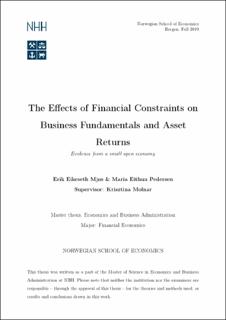The effects of financial constraints on business fundamentals and asset returns : evidence from a small open economy
Master thesis
Permanent lenke
https://hdl.handle.net/11250/2644659Utgivelsesdato
2019Metadata
Vis full innførselSamlinger
- Master Thesis [4372]
Sammendrag
In this thesis we investigate whether financially constrained firms are fundamentally riskier
than unconstrained firms, whether this risk is priced in the form of a financial constraint
factor, and whether the financial constraint factor represents an independent source of
return movements. The investigation will be in the context of the Norwegian economy
and securities markets.
Using various measures of financial constraints, we form portfolios of constrained and
unconstrained firms in a similar fashion to Fama and French (1992). Following Campello
and Chen (2010) we estimate differences in the real business risk of constrained and
unconstrained firms by regressing their median real operating earnings- and investment
growth on macroeconomic and credit market variables. We test whether the risk is priced
by subtracting the monthly stock market returns of constrained firms from unconstrained
firms, creating a financial constraint factor. Finally, following Lamont et al. (2001), we
investigate whether the financial constraint factor represents an independent source of
movement in returns by regressing it on benchmark asset pricing models, including Sharpe
(1964) and Lintner (1965)’s CAPM, the Fama and French (1992) three-factor model and
the Fama and French (2015) five-factor model.
We find evidence that financially constrained firms are fundamentally riskier than
unconstrained firms, and that this risk is priced in the form of a financial constraint
factor. The results point to financial constraints being time-varying and binding more in
downturns than expansions. We find that a negative oil price shock is associated with
increasing financial constraints in the Norwegian economy. Furthermore, we find that
financially constrained firms in Norway behave in a similar fashion to constrained firms in
the US, suggesting that financial constraints are not significantly different across various
economic settings. Finally, the combined real-financial results point to the existence of a
macroeconomy-equity valuation channel along the lines of Gertler and Bernanke (1989).
